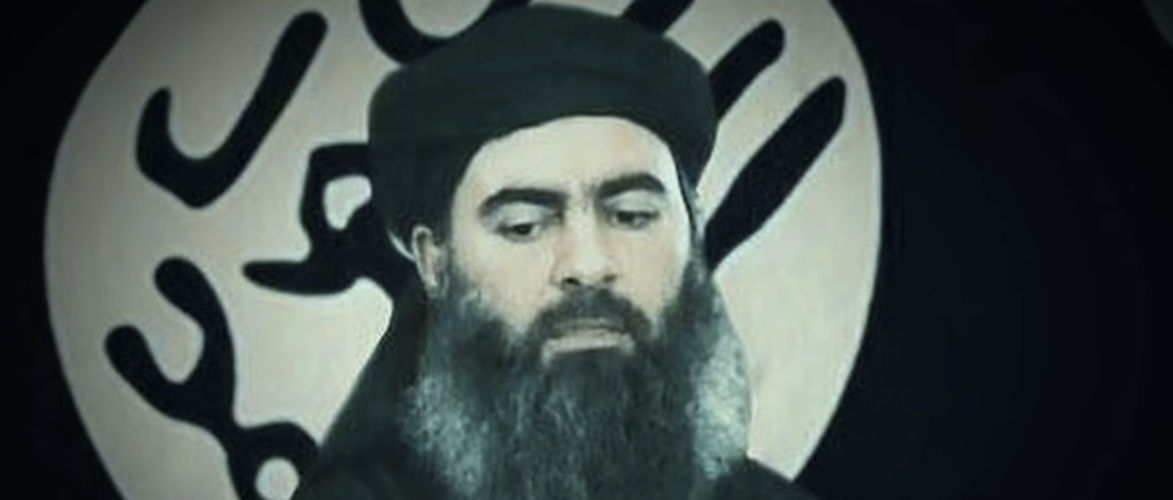A comment by Rainer Rupp.
If you believe US President Trump and the US military, the infamous ISIS chief terrorist is now dead for the fifth or sixth time. Every time after the earlier reports about his death, the proverb of the “dead who live longer” was kept.
The first time al-Baghdadi had been declared dead was in 2010, when on April 19, Reuters news agency reported, citing a statement by Iraqi Prime Minister Nuri al-Maliki, that “the leader of Al-Qaida in Iraq, Abu Ayyub al-Masri, and the alleged head of the local branch of the Islamic State of Iraq, Abu Omar al-Baghdadi, had been found dead in a hole in the basement of a house after it was surrounded and stormed by troops”.
But the US army immediately claimed its share of this apparent success. According to the New York Times (1), immediately after Prime Minister Maliki’s press conference the American military issued a statement confirming that al-Baghdadi had been killed in a joint attack by Iraqi and American forces in a house near Tikrit (2)
This incident was quickly forgotten after al Baghdadi, an extremely brutal but brilliant leader of the Islamic state, had conquered large parts of Sunni Iraq and the bordering Syrian-Arab regions some time later. Then, on June 29, 2014, a spokesman for the Islamic State in Iraq and the Levant (ISIL) announced that the group would henceforth operate under the name “Islamic State” (IS). He declared the “IS” a caliphate and Baghdadi its ruler. Thus Abu Bakr al-Baghdadi became the “Caliph Ibrahim”. The title “Caliph” made him a direct successor of the Prophet Mohammed.
Then, at the beginning of September, based on official Iraqi government reports, the news of the death of “Caliph” al-Baghdadi, together with photos of his body, went around the world again, only to be denied by the US a few days later on September 8, 2014. It may have been in Washington’s interest at that time not to declare al-Baghdadi dead but to keep him alive, as it was only in this way that the return of US combat troops to Iraq was made possible.
Previously, in 2011, the Iraqi government had succeeded with clever moves in persuading US President Obama to withdraw all US combat troops from Iraq. In the following years Obama was endlessly criticized by the Deep State in Washington for the fact that he had released Iraq, a fat prey with its rich energy reserves and a key geo-strategic position in the Middle East, from direct US control. But then ISIL came to the rescue. Thanks to the military success of the ISIL terrorists, who eventually threatened the capital Baghdad, the Iraqi government asked the US army for help in 2014. The day was saved for the US imperialists.
Although ISIL has not existed in Iraq for about two years as a war-like combat formation, and the Iraqis would cope well with the crushed ISIL leftovers, Washington does not think about it, despite repeated demands from Baghdad to leave Iraq again. Washington officially justifies this with the argument: “If we leave Iraq now, ISIL will gather and quickly strengthen again. With this justification, one can of course stay in Iraq forever!
In spring 2015, reports circulated for months that al Baghdadi had already been seriously wounded in a US air raid on ISIL positions in March. While Radio Iran later reported that he had died of the injuries, Martin Chulov of the Guardian, for example, who has good contacts to Iraq and IS supporters there, reported that al-Baghdadi “is still unable to work due to suspected spinal damage and is being treated by two doctors who travelled from the group’s stronghold in Mosul to his hiding place”.
Other sources have reported that ISIS field commanders have come together to appoint a successor to “Caliph Ibrahim”, speculating whether this will lead to a weakening of the terrorist organisation.
Only the Americans were not interested in the matter, especially not in a possible weakening of ISIL, which proved to be an extremely useful enemy. For example, in June 2015 (3) CNN reported, citing a US government official, that there was “no information” indicating that al-Baghdadi had been injured. In addition, he “absolutely participates in the daily ISIS ‘race'”.
The next rumours of al-Baghdadi’s death circulated in early December 2016, during ISIL’s loss-making withdrawal from Iraq across the border into Syria. Since then one did not speak any more of ISIL but only of ISIS (Islamic state in Syria) or simply IS. According to the UK-based Syrian Observatory For Human Rights, top ISIL commanders had met at the time to find a successor to al Baghdadis. It was therefore speculated again(4) that the caliph had been killed or seriously injured in the Mosul offensive of the Iraqi armed forces, with the support of the US Air Force. At the time, a number of top terrorists had bitten the dust: notably the Chechen Abu Omar, the Tunisian Abu Hija, and the Iraqi Abu Osama.
At the beginning of June 2017 the time had come again and the news of al Baghdadi’s death made headlines worldwide. This time he was most likely killed in a Russian air raid in the Syrian ISIS stronghold of Raqqa. According to intelligence reports, a meeting of the ISIS leadership had taken place there to plan the defense of Raqqa, the besieged “capital” of the “Caliphate”.
The Ministry of Defence in Moscow confirmed that an attack had taken place on 28 May after information had been received about the meeting of the ISIS leadership. But the Russians warned against hasty conclusions: “According to the information now being examined through various channels, [Isis] leader Abu Bakr al-Baghdadi was present at the meeting and eliminated from the air strike.
The 10-minute Russian air raid, in which Baghdadi was killed, killed half a dozen high-ranking leaders of the terrorist organization, 30 field commanders and more than 300 fighters who had been called in to guard the meeting, the British Independent commented.
And now al Baghdadi is said to have blown himself up with an explosive belt to avoid capture by a US special unit. In light of the past history, it is no wonder that many doubt the official US version. Idlib, where al Baghdadi is said to have been, is the last bastion of Islamic cutthroats in northwestern Syria. According to their own statements, the Russians observe it very closely and monitor it electronically all around.
In the questionable time of the alleged US operation no US flight activities were determined in the region concerned, so the official statement of the Russians. There could be two explanations which did not make the Russians look good. Firstly, the new US fighter F-35 with their improved stealth capability could be better than their reputation and they were invisible to the Russian electronic defence system; then the Russians would have a huge problem, or, secondly, there was a blow with a kinetic weapon from space, which the Pentagon has been working on for a long time and which it wanted to try out on this occasion.
In the whole al Baghdadi story, the many similarities with the Osama bin Laden narrative are striking. Also bin Laden had risen from the dead several times, but afterwards you never knew if the “new” bin Laden was the same as the old bin Laden. A well-known Harvard engineer specializing in speech analysis, for example, claimed that bin Laden’s alleged original tapes were different people.
It is also striking that the mortal remains of al Baghdadi as well as those of bin Laden were loaded into a helicopter and then disposed of over the sea; at least in both cases the official version. Why? Who or what do we want to prevent with this destruction of evidence, namely the corpses?
At least no more DNA samples are possible without corpses. That would make some sense if you take into account the story of some high-ranking US generals about al-Baghdadi:
12 years ago, on July 18, 2017, the New York Times wrote: “For more than a year, the leader of one of the most notorious insurgent groups in Iraq, the Islamic State, has been said to be a mysterious Iraqi named Abu Omar al-Bagdadi… Despite the claim of a representative of the Iraqi Ministry of the Interior in May that Baghdadi was killed, he seemed to remain unharmed.”
On Wednesday, the chief spokesman of the US military in Iraq, General Kevin J. Bergner, presented a new statement for “al Baghdadi’s ability to escape any attack: He doesn’t even exist.” According to General Bergner, a high-ranking Iraqi insurgent who was recently captured has declared that the elusive al Baghdadi is indeed an invented figure whose statements are read on tape by a man named Abu Abdullah al-Naima.
This would mean that any number of people could play al-Baghdadi. Just as James Bond was first played by Sean Connery, then by Roger Moore and then by Daniel Craig. Therefore, Al Baghdadi cannot be defeated, because if one is dead, the next takes over his role.
Since almost nothing was known about Baghdadi’s personal characteristics, he always lived in seclusion and only had a small leadership circle, it would indeed have been easy for successors to take on the role of al Baghdadi in the event of a failure.
This “conspiracy theory” of US General Berger could therefore be a plausible explanation for the many lives of al Baghdadi. Let’s see if he even comes back from the bottom of the sea this time?
Sources:
- https://www.nytimes.com/2010/04/20/world/middleeast/20baghdad.html
- https://www.newyorker.com/news/amy-davidson/the-deaths-of-al-baghdadi
- https://edition.cnn.com/2015/05/11/middleeast/isis-leadership/index.html
- https://www.thesun.co.uk/news/2328952/bloodthirsty-isis-leader-abu-bakr-al-baghdadi-rumoured-to-be-dead-after-senior-jihadis-are-called-to-a-secret-meeting-to-select-his-successor/
+++
Thanks to the author for the right to publish.
+++
Picture hint: Screenshot YT ABCNews
+++
KenFM strives for a broad spectrum of opinions. Opinion articles and guest contributions do not have to reflect the editorial point of view.
+++
You like our program? Information on support options can be found here: https://kenfm.de/support/kenfm-unterstuetzen/
+++
Now you can also support us with Bitcoins.

BitCoin Adresse: 18FpEnH1Dh83GXXGpRNqSoW5TL1z1PZgZK










Kommentare (0)